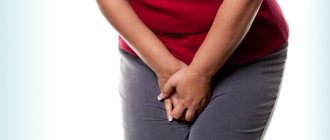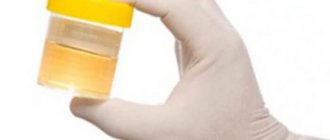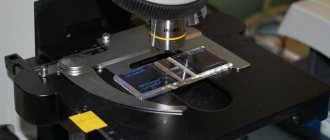A common problem after childbirth is urinary incontinence. This is a disorder of the urinary system, which affects approximately 10% of girls during their first pregnancy and 21% during the second. Since involuntary urination is an abnormal phenomenon, it requires correction. Competent therapy guarantees quick relief from pathology.
Cause of incontinence
Urination disorder is caused by stretching and weakening of the pelvic floor (perineum) muscles - the muscular-fascial layer that maintains the normal position of the internal organs and regulates intra-abdominal pressure.
The muscles stretch due to the heaviness of the uterus and fetus, and weaken due to complicated childbirth and injuries.
Incontinence occurs due to:
- disorders of the nervous regulation of the pelvic floor muscles and pelvic organs;
- urethral mobility;
- fluctuations in intravesical pressure.
Postpartum involuntary urination refers to stress incontinence, when a small amount of urine is released during exercise, coughing, or intimacy. The condition is not dangerous, but if treatment is refused or ignored, the problem will worsen. Neglected cases are difficult to correct.
Risk factors
Conditions that increase the likelihood of pathology occurring:
- excess weight;
- multiple pregnancy;
- hormonal imbalance;
- genetic predisposition;
- infectious processes;
- mental disorders;
- second and subsequent natural births;
- anatomical features (narrow pelvis).
The risk of experiencing urinary incontinence is directly proportional to the number of births. If the disorder does not arise after the first, the second and subsequent ones increase the likelihood of its occurrence.
Classification
Urinary incontinence occurs:
- Stressful - urine production is provoked by coughing or exertion.
- Reflexive ㅡ occurs as a result of external circumstances, for example, the sound of pouring water.
- Nocturnal enuresis - involuntary urination during sleep.
- Imperative ㅡ due to a sudden, strong urge.
Urine can also leak when the bladder is full, or even after visiting the toilet.
Negative factors
There are a number of other factors that cause urinary incontinence after childbirth. How to treat? Depends on the pathogenesis.
- Operations. Various types of surgical interventions damage nerves and blood vessels, as well as muscles. Childbirth makes the situation worse.
- Heredity. If someone in the family had problems, then the woman can inherit them.
- Injuries. Fractures or bruises of the spine affecting its lower parts lead to problems with urination.
- Neurological pathologies. In this case, therapy is prescribed by a neurologist, since the functioning of the nervous system is disrupted.
Clinical picture
Urinary incontinence is accompanied by:
- sensation of a foreign body in the vagina;
- feeling of incomplete emptying of the bladder;
- a strong desire to visit the toilet;
- involuntary, frequent release of urine (even a few drops).
If you have such symptoms, you should consult a doctor.
Table ㅡ Stages of urinary incontinence
| Degree | Characteristic |
| Lightweight | Urine is released during intense physical activity |
| Average | Episodes of leakage occur when the abdominal muscles tense (triggered by laughing, coughing or sneezing) |
| Heavy | Women experience urinary incontinence even during night rest and when turning while lying down |
Urinary incontinence in women after childbirth - what is it?
- Urine leakage occurs involuntarily at the slightest physical exertion. This can happen when jumping, standing up suddenly, squatting and bending.
- A woman does not control the process of urine excretion when lying down or having sexual intercourse.
- The woman feels discomfort. There is a feeling as if there is a foreign object in the vagina.
- I constantly want to go to the toilet for a little while.
- Incontinence worsens when drinking alcohol.
- The volume of urine is minimal when straining, and may leak throughout the day.
Diagnostics
In addition to the survey, the doctor will conduct a special test during the examination. To do this, a woman, while on a gynecological chair, is asked to imitate a cough. If a small amount of urine is released, the test is considered positive. In addition to this, it is important for the girl to keep a diary for two days, where she needs to record the frequency of urges, the volume of fluid (per bowel movement), and episodes of urinary incontinence. Thanks to observations, it is possible to assess the dynamics of the pathology.
In addition to the test and keeping a diary, the following diagnostic methods are prescribed:
- blood and urine tests;
- ultrasound examination of the kidneys and pelvic organs;
- uroflowmetry ㅡ testing to determine the dynamics of the lower urinary tract;
- profilometry ㅡ to assess the condition of the urethra;
- cystometry ㅡ to study abnormalities in the functioning of the bladder.
Possible complications of postpartum incontinence
Stress urinary incontinence after childbirth usually resolves within a couple of weeks with the help of conservative treatment methods (exercises, physical therapy). If the course of the disease is complex, a woman should immediately contact a specialist. This will avoid a number of possible complications, in particular, infections and prolapse of the pelvic organs.
Comparative table of complications of postpartum incontinence
Type of complication | Symptoms of manifestation |
| Skin infections | Ulcers and rashes appear on the surface of the body, caused by high levels of humidity. Additionally, the problem aggravates the wound healing process and promotes the development of fungus. |
| Pelvic organ prolapse | Manifests itself in the form of displacement of the vagina, bladder and urethra from their anatomical location. |
Treatment
The main goal of therapy is to tone the pelvic muscles. Almost always, in addition to the basic methods, special exercises are recommended. Surgery is necessary if the situation cannot be corrected by other means.
Conservative therapy
You can strengthen muscles and normalize the functioning of the urinary system with the help of medications (prescribed strictly by a doctor), gymnastics, and physiotherapy.
Incontinence is easier to treat early.
Set of exercises
Gymnastics helps normalize muscle tone, improve the functioning of the urinary system, and strengthen the regulation of urination. Exercises are performed while lying on your back:
- It is necessary to raise your legs (first the left, then the right, then both) until an angle of 45 degrees is formed.
- Focusing on your feet and shoulders, you need to lift your pelvis.
- The next exercise consists of spreading your legs, pressed to the floor to the sides (performed with effort).
- Lying on your back and raising your legs up (at an angle of 90 degrees), you need to make circular movements, as if imitating riding a bicycle.
It is useful for women to do Kegel exercises. Gymnastics is aimed at strengthening the muscles of the perineum. They can be felt if you try to stop the flow of urine while urinating. The point of Kegel exercises is to alternately tense and relax the muscles of the perineum. To get started, just do 30 repetitions. Gradually, their number needs to be increased to 300. There are several rules for the effectiveness of Kegel exercises:
- you need to go to the toilet in advance;
- to enhance the effect, it is recommended to do gymnastics with legs spread wide apart;
- the muscles of the buttocks and abdomen should be relaxed;
- For beginners, it is better to perform such gymnastics in a lying position for the first time.
There is a modernization of Kegel exercises ─ using a special set of weights (weights). The direction is called wumbling.
Physiotherapy
Prescribed in combination with therapeutic exercises. Helps overcome involuntary urination and normalize the functioning of the body. Among the physiotherapeutic procedures, the most effective are:
- Electrical stimulation. Strengthens the pelvic floor and improves the urination process. Not recommended for women with cancer or heart problems.
- Electrophoresis. The action of direct current and medications has a beneficial effect on the functioning of the urinary organs, which helps eliminate incontinence.
- Ultrasound therapy. Stimulates the nervous system, normalizes impulse transmission processes. The technique also improves blood circulation in the urinary system.
- Diadynamic therapy. Stimulates the bladder sphincter, due to which urine is retained in the anatomical reservoir.
Surgical intervention
If conservative treatment methods fail to cure urinary incontinence, women are prescribed radical treatment. Minimally invasive methods are used for this problem:
- Loop surgery. The essence of the method is to place a synthetic loop under the urethra to provide additional support and simulate a bend. It is performed using anesthesia and lasts about one and a half hours.
- Introduction of gel (hyaluronic acid). A gel is injected throughout the entire urethra. As a result, the lumen of the urethra narrows. The procedure can be performed on an outpatient basis.
Another way to combat urinary incontinence is to perform urethrocystocervicopexy. This is a complex operation that is performed under general anesthesia. During this procedure, the pubovesical ligaments that hold the urethra and bladder neck are strengthened. Sometimes a special synthetic mesh is used to support the pelvic floor muscles. Such operations are called TVT.
Incontinence itself is extremely rare and often requires medical intervention. Although the condition is not dangerous to health, it reduces the quality of life. By leaving urinary incontinence (even if it is insignificant) unattended, you can miss a favorable moment for therapy and, in the presence of inflammation or an infectious process, allow complications to develop.
Only enuresis is treated with medication; for other types of incontinence, drugs are not effective.
Principles of therapy for involuntary urinary leakage
The birth of a child is an exciting and responsible moment. What to do if urinary incontinence begins after childbirth?
If a woman begins to experience incontinence after childbirth, then treatment should begin immediately. The doctor determines the time after which the first urine flow occurred after childbirth. After the birth of a baby, a woman begins the postpartum period. It lasts one and a half months.
During this time, the woman’s body is completely restored.
All functions and structure of tissues, systems and organs that were disrupted during childbirth are normalized. During this period, doctors do not treat pathological processes; this concerns involuntary urine discharge.
Doctors recommend not lifting heavy objects and having bowel movements regularly.
Treatment for urinary incontinence begins one and a half months after the birth process, if the woman’s pathological symptoms have not gone away.
Doctors face four challenges:
- decreased frequency of urination;
- prolongation of intervals between urinations;
- increased bladder volume;
- improving the quality of life of a young mother.
A conservative treatment method involves training the muscles in the pelvic floor and bladder. To do this, doctors use the Kegle technique, which allows you to train the vaginal muscles and hold small loads. Thanks to these exercises, normal activity of the vaginal muscles is restored.
Also, the exercises that are included in the Kegle method can be done at a time convenient for you. The patient should tense the muscles that surround the bladder and rectum for a few seconds and then relax them. This exercise needs to be done 210 times a day. You can find the right muscles by holding back the stream of urine during the urination process.
A positive effect can be achieved by regular bladder training. A schedule for urinary processes is individually developed for each patient.
During this period, the woman should empty her bladder with minimal filling. This program is designed for a short period, which turns into a maximum (up to 4 hours).
Drug therapy is carried out in addition to exercises and training of the vaginal muscles.
Modern medicine is rich in drugs of various types of action. But there are no medications against urinary incontinence. Treatment is carried out with sedatives, drugs that improve blood circulation and strengthen vascular walls. The doctor may prescribe a vitamin complex.
Surgical treatment is prescribed only when conservative therapy does not produce the expected results.
Factors provoking the appearance of pathology
Urinary incontinence in women after childbirth is associated with dysfunction of the pelvic floor muscle tissue. When carrying a child, the muscles that hold it in the womb are subject to high stress. They lose elasticity and firmness. The development of the disease can be triggered by a long and difficult maternity process. Women who give birth again are also at risk. The key reasons for the development of the disease include:
- problems in the muscles of the bladder and pelvic floor;
- defects in the closure function of the bladder and pelvic floor;
- mobility of the urethral emission channel, related to the pathological type;
- unstable position of the bubble;
- pressure surges inside the bubble.











